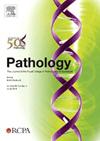The number of potential gateways determines prognostic value of tumour deposits in colon cancer
IF 3
3区 医学
Q1 PATHOLOGY
引用次数: 0
Abstract
Tumour deposits (TD) are a crucial biomarker in colorectal cancer, closely associated with nearby structures such as blood vessels, lymphatic vessels, and peripheral nerves. These anatomical structures serve as pathways that facilitate the spread of tumour cells throughout the body. This study aims to investigate how TD access these anatomical gateways and how these variations impact patient survival. We analysed colon carcinoma patients who underwent surgery at Radboud University Medical Centre between 1986 and 2012 for the presence of TD. Using serial sections and immunohistochemistry with four different antibodies (CD34, D2-40, S100, and elastic van Gieson), we examined the presence and distribution of TD access to surrounding anatomical structures, including blood vessels, lymphatic vessels and peripheral nerves. In 127 patients, 280 TD were examined. Of these, 112 TD (40%) had multiple access points, 109 TD (39%) had a single access point, and 59 TD (21%) had no discernible access point. More than half of the TD (57%) demonstrated haematovascular invasion. Patients with TD featuring a single access point had a better prognosis compared to those with multiple access points (5-year overall survival, p=0.025; 5-year disease-free survival, p=0.005). TD are a heterogeneous biomarker characterised by various access points, with haematovascular invasion being the most common. Our study highlights a direct correlation between the number of TD access points and patient outcomes, indicating that an increase in access points is linked to a poorer prognosis.
潜在通道的数量决定了结肠癌肿瘤沉积物的预后价值。
肿瘤沉积物(tumor deposits, TD)是结直肠癌的重要生物标志物,与附近的血管、淋巴管和周围神经等结构密切相关。这些解剖结构是促进肿瘤细胞在全身扩散的途径。本研究旨在探讨TD如何进入这些解剖通道,以及这些变化如何影响患者的生存。我们分析了1986年至2012年间在内梅亨大学医学中心接受手术的结肠癌患者是否存在TD。使用四种不同抗体(CD34, D2-40, S100和elastic van Gieson)的连续切片和免疫组织化学,我们检查了TD进入周围解剖结构的存在和分布,包括血管,淋巴管和周围神经。在127例患者中,检查了280例TD。其中,112个TD(40%)有多个接入点,109个TD(39%)有单个接入点,59个TD(21%)没有可识别的接入点。超过一半的TD(57%)表现为血管侵犯。与具有多个接入点的患者相比,具有单一接入点的TD患者预后更好(5年总生存率,p=0.025;5年无病生存率,p=0.005)。TD是一种异质性生物标志物,具有不同的接入点,以血管侵袭为最常见。我们的研究强调了TD接入点数量与患者预后之间的直接相关性,表明接入点的增加与预后较差有关。
本文章由计算机程序翻译,如有差异,请以英文原文为准。
求助全文
约1分钟内获得全文
求助全文
来源期刊

Pathology
医学-病理学
CiteScore
6.50
自引率
2.20%
发文量
459
审稿时长
54 days
期刊介绍:
Published by Elsevier from 2016
Pathology is the official journal of the Royal College of Pathologists of Australasia (RCPA). It is committed to publishing peer-reviewed, original articles related to the science of pathology in its broadest sense, including anatomical pathology, chemical pathology and biochemistry, cytopathology, experimental pathology, forensic pathology and morbid anatomy, genetics, haematology, immunology and immunopathology, microbiology and molecular pathology.
 求助内容:
求助内容: 应助结果提醒方式:
应助结果提醒方式:


